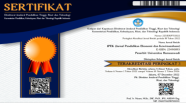Penerapan Flipped Classroom Dalam Pembelajaran Daring (Synchronous Dan Asynchronous) Di Jurusan Pendidikan Ekonomi Universitas Siliwangi
DOI:
https://doi.org/10.29408/jpek.v5i2.4450Keywords:
Flipped Classroom, Online Learning (Synchronous And Asynchronous)Abstract
The flipped class method was implemented to observe the difference of student scores before and after applied. The method of research was classroom action research in two cycles. The population were Department of Economics Education’s students of Siliwangi University. Technique sampling in this study was purposive sampling with a total sample 77 students. Data analysis was carried out in two ways, descriptive analysis and t-test comparison test. The average score of student before implementing flipped classroom method was 69.247, after the first cycle the student pretest score was 69.714, and the average student score at the end of the second cycle was 80.104. The t-statistic value was 15,895 greater than 1,99167 (t table 5%). Based on these results, it can be concluded that student scores has increased significantly after the flipped classroom implemented in online learning (synchronous and asynchronous) at the Department of Economics Education, University of SiliwangiReferences
Akçayır, G., & Akçayır, M. (2018). The flipped classroom: A review of its advantages and challenges. Computers and Education, 126(July), 334–345. https://doi.org/10.1016/j.compedu.2018.07.021
Ali, W. (2020). Online and Remote Learning in Higher Education Institutes: A Necessity in light of COVID-19 Pandemic. Higher Education Studies, 10(3), 16. https://doi.org/10.5539/hes.v10n3p16
Arikunto, S., Suhardjono, S., & Supardi, S. (2015). Penelitian Tindakan Kelas (1st ed.). Bumi Kasara.
Baepler, P., Walker, J. D., & Driessen, M. (2014). It’s not about seat time: Blending, flipping, and efficiency in active learning classrooms. Computers and Education, 78, 227–236. https://doi.org/10.1016/j.compedu.2014.06.006
Guan, W., Ni, Z., Hu, Y., Liang, W., Ou, C., He, J., Liu, L., Shan, H., Lei, C., Hui, D. S. C., Du, B., Li, L., Zeng, G., Yuen, K.-Y., Chen, R., Tang, C., Wang, T., Chen, P., Xiang, J., … Zhong, N. (2020). Clinical Characteristics of Coronavirus Disease 2019 in China. New England Journal of Medicine, 382(18), 1708–1720. https://doi.org/10.1056/nejmoa2002032
Hart, C. M. D., Berger, D., Jacob, B., Loeb, S., & Hill, M. (2019). Online Learning, Offline Outcomes: Online Course Taking and High School Student Performance. AERA Open, 5(1), 233285841983285. https://doi.org/10.1177/2332858419832852
Herliandry, L. D., Nurhasanah, N., Suban, M. E., & Kuswanto, H. (2020). Pembelajaran Pada Masa Pandemi Covid-19. JTP - Jurnal Teknologi Pendidikan, 22(1), 65–70. https://doi.org/10.21009/jtp.v22i1.15286
Hrastinski, S. (2008). Asynchronous and Synchronous E-Learning. Educause Quarterly, 31(4), 51–55. https://doi.org/10.1080/00071667608416307
Huang, C., Wang, Y., Li, X., Ren, L., Zhao, J., Hu, Y., Zhang, L., Fan, G., Xu, J., Gu, X., Cheng, Z., Yu, T., Xia, J., Wei, Y., Wu, W., Xie, X., Yin, W., Li, H., Liu, M., … Cao, B. (2020). Clinical features of patients infected with 2019 novel coronavirus in Wuhan, China. The Lancet, 395(10223), 497–506. https://doi.org/10.1016/S0140-6736(20)30183-5
Izagirre-Olaizola, J., & Morandeira-Arca, J. (2020). Business management teaching–learning processes in times of pandemic: Flipped classroom at a distance. Sustainability (Switzerland), 12(23), 1–18. https://doi.org/10.3390/su122310137
Johnson, G. M. (2006). Synchronous and Asynchronous Text-Based CMC in Educational Contextts: A Review of Recent Research. Tech Trends, 50(4), 46–53.
Long, T., Cummins, J., & Waugh, M. (2016). Use of the flipped classroom instructional model in higher education: instructors’ perspectives. Journal of Computing in Higher Education, 29(2), 179–200. https://doi.org/10.1007/s12528-016-9119-8
Mahmood, S. U., Syed, F., Khan, N. R., Batool, Z., & Rehman, R. (2017). Comparison of problem based with case based learning: A cross-sectional study. Pak J Physiol, 13(4), 52–56.
Mishra, L., Gupta, T., & Shree, A. (2020). Online teaching-learning in higher education during lockdown period of COVID-19 pandemic. International Journal of Educational Research Open, 1(June), 100012. https://doi.org/10.1016/j.ijedro.2020.100012
O’Flaherty, J., & Phillips, C. (2015). The use of flipped classrooms in higher education: A scoping review. Internet and Higher Education, 25, 85–95. https://doi.org/10.1016/j.iheduc.2015.02.002
Offir, B., Lev, Y., & Bezalel, R. (2008). Surface and deep learning processes in distance education: Synchronous versus asynchronous systems. Computers and Education, 51(3), 1172–1183. https://doi.org/10.1016/j.compedu.2007.10.009
Peraturan Pemerintah Nomor 21 Tahun 2020, Pub. L. No. PP Nomor 21 Tahun 2020, 1 (2020).
Rehman, R., & Fatima, S. S. (2021). An innovation in Flipped Class Room: A teaching model to facilitate synchronous and asynchronous learning during a pandemic. Pakistan Journal of Medical Sciences, 37(1), 1–6. https://doi.org/10.12669/pjms.37.1.3096
Shah, R. K., & Barkas, L. A. (2018). Analysing the impact of e-learning technology on students’ engagement, attendance and performance. Research in Learning Technology, 26(1063519). https://doi.org/10.25304/rlt.v26.2070
Siegal, W., Church, A. H., Javitch, M., Waclawski, J., Burd, S., Bazigos, M., Yang, T., Anderson‐Rudolph, K., & Warner Burke, W. (1996). Understanding the management of change. Journal of Organizational Change Management, 9(6), 54–80. https://doi.org/10.1108/09534819610150521
Sohrabi, B., & Iraj, H. (2016). Implementing flipped classroom using digital media: A comparison of two demographically different groups perceptions. Computers in Human Behavior, 60, 514–524. https://doi.org/10.1016/j.chb.2016.02.056
Susana, K., & Brahma, A. A. (2020). The Implementation of Flipped Learning in Writing Class During the Pandemic: Students’ Perceiption and Reflection. International Seminar on Language, Education, & Culture (ISoLEC), 68–75. http://isolec.um.ac.id/?p=501
Tan, C., Yue, W.-G., & Fu, Y. (2017). Effectiveness of flipped classrooms in nursing education: Systematic review and meta-analysis. Chinese Nursing Research, 4(4), 192–200. https://doi.org/10.1016/j.cnre.2017.10.006
Tang, Y. M., Chen, P. C., Law, K. M. Y., Wu, C. H., Lau, Y. yip, Guan, J., He, D., & Ho, G. T. S. (2021). Comparative analysis of Student’s live online learning readiness during the coronavirus (COVID-19) pandemic in the higher education sector. Computers and Education, 168(March). https://doi.org/10.1016/j.compedu.2021.104211
UNESCO. (2021). COVID-19 educational disruption and response. UNESCO. https://en.unesco.org/covid19/educationresponse
Wardani, I. G. A. . (2007). Penelitian Tindakan Kelas. In Universitas Terbuka (1st ed.). Universitas Terbuka. https://doi.org/10.21831/jpai.v6i1.1793
WHO. (2021). Coronavirus disease 2019 (COVID-19) dashboard. https://covid19.who.int/
Widyaningrum, B., & Surindra, B. (2018). Problem Based Learning Application Using Lesson Study Approach To Improve the Effectiveness of Mathematical Economic Learning. European Journal of Education Studies, 5(6), 244–252. https://doi.org/10.5281/zenodo.1495337
Zhang, W., Wang, Y., Yang, L., & Wang, C. (2020). Suspending Classes Without Stopping Learning: China’s Education Emergency Management Policy in the COVID-19 Outbreak. Journal of Risk and Financial Management, 13(3), 55. https://doi.org/10.3390/jrfm13030055




